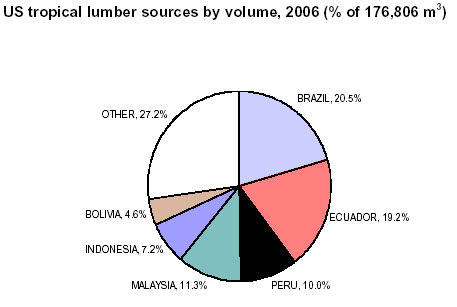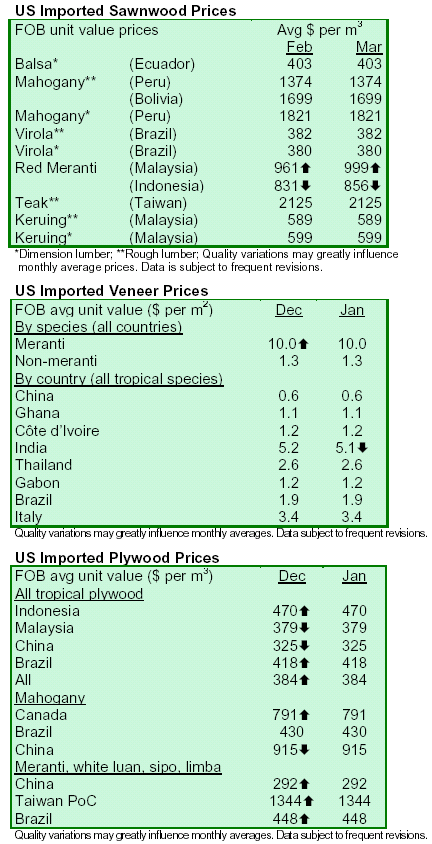|
Brazil retains greatest market share of US lumber
imports
This third article of a series focuses on wood imports by country of origin from 2001 to 2006. Statistics from the
US on tropical lumber imports indicated that overall tropical lumber imports in the US advanced from 231,615
m3 in 2001 to 353,985 m3 in 2005. However, imports steeply declined in 2006 by approximately 55,000 m3, or
24% from 2005 levels.
In 2006, the US imported two-thirds of its tropical wood requirements from Central and South America, one-fourth
form Asia and less than 10% from Africa. In the same year, Brazilí»s export volume was 36,204 m3, down 43%
from 2001 levels. Brazil maintained the top spot of the market share based on export volumes (21%) and export
values, despite the fact that Brazilí»s prime export was the relatively inexpensive virola mahogany species. Despite
this, 2006 shipments of all tropical wood from Brazil were 27.4 million, or 36.1 million less than in 2001. Supply of
virola (7,945 m3 in 2006) was falling, due to environmental concerns about the Amazon rain forests.
Ecuadorí»s market share increased from 3.9% to 19.2% in 2006. Although volume of imports in 2006, 33,915m3 ,
was up 200% from 10,713 m3 in 2001, it was down from 2004 volumes. Ecuadorí»s primary export species was
Balsa wood, which made up almost all the 99.8% of wood exports.
Peruvian imports had also significantly decreased from 2001. In 2006, imports stood at 17,727 m3, and 7,000 m3
consisted of mahogany species. Peru was also increasing its exports of virola, with current volume standing at 3,454
m3. Although Peruí»s market share of US lumber imports in 2006 on the basis of volume was 10%, its share on a value
basis was 16%, or US$21.2 million, largely due to the cost of expensive mahogany imports.
Outside of Latin America, Malaysiaí»s share of overall imports of tropical woods fell from 12% in 2001 to 11% in
2006. The most abundant species shipped from Malaysia to the US were red meranti and keruing. Contrary to the
generally declining volumes of wood exports, Malaysia
increased its red meranti exports from 2001-2006.

Although other Latin American exportersí» volumes were
each under 10%, Bolivia was able to increase its tropical lumber exports to the US during the past five years. This
occurred despite the fact that Bolivian shipments of mahogany had been declining.
Among the species exported to the US, teak was the more expensive wood. The average price of imported teak was
1695 / m3. However, teak prices fell 25% from 2001 prices, despite the fact that the price index for overall
tropical lumber imports in the US increased 7% during 2001-2005.

íí
|